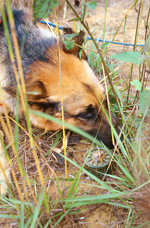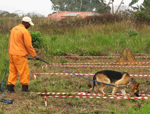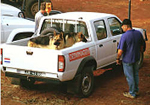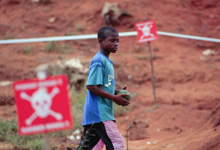Dog Detection

Up until today, there is no better scent detector than the nose of a dog.

Because they are loyal and easily trainable, German and Belgian shepherd dogs are used for mine detection.
The right nose
There are more than 700 known types of mines. They are made from wood, metal, compressed explosive, plastic, bakelite and even glass. They are round, cornered, flat or thick, asymmetrical, lightweight, heavy, large or small. They are brown, red, blue, black, green, sand coloured or grey. The only thing they have in common is the high explosive inside. Which makes the detection of explosives one of the most important methods of mine detection. Unmatched for that task today is the nose of a dog, also referred to as a “bio-sensor”. Apart from mine detection, dogs are extensively used for the equally important task of determining which areas are not mined (Mined Area Reduction).
The successful detection of explosives by dogs is based on utilising the animal’s urge to play. This makes a special relationship between the animal and its handler critically important. If the dog is not in the mood to play, it will not detect mines reliably.
The search is conducted with the dog on a long leash, clearing the area in a figure-of-eight search pattern. If the dog detects the scent of explosives, it lies down (nose first) 10 cm away from the signal. After the spot is marked, deminers with the aid of metal detectors investigate and unearth the target which may be up to 25 cm deep. As a reward for its work, the handler will play with the dog.

When the heat from high ground temperatures bother the dogs too much, the work and training times are moved to the early mornings or the late evenings.

Often the dog teams are the first to leave camp early in the morning...
All existing attempts to duplicate these "animal" sensors with electronic technology have had limited success. The problem is that only an animal can smell in the higher (scent) regions necessary to detect explosives. But dogs are prone to illness and can only concentrate on their work for a few hours, so the search for other suitable animals began. Among others, pigs, mungos, butterflies and cockroaches have been considered. MgM believes that a viable alternative may involve the use of trained laboratory rats.
After a year-long positive experience with the MgM dog team under the guidance of our South-African experts, it was decided to increase our four legged capacity. Of course, at the same time it was important to train good handlers for the new dogs. The first candidate was the deminer who had worked in the dog team. The result was exceptional. Because the deminer had followed every step of the dogs for over a year with intelligent interest, he was 100% ready for deployment in only four weeks. The training of the dog team's driver/radio-operator as a handler followed, with similar results. Cross training of MgM personnel is common, and essential to our operations.
Currently MgM operates two dog training camps in Angola. One is in Ambriz, North of Luanda and the second is in Southern Ondjiva.





